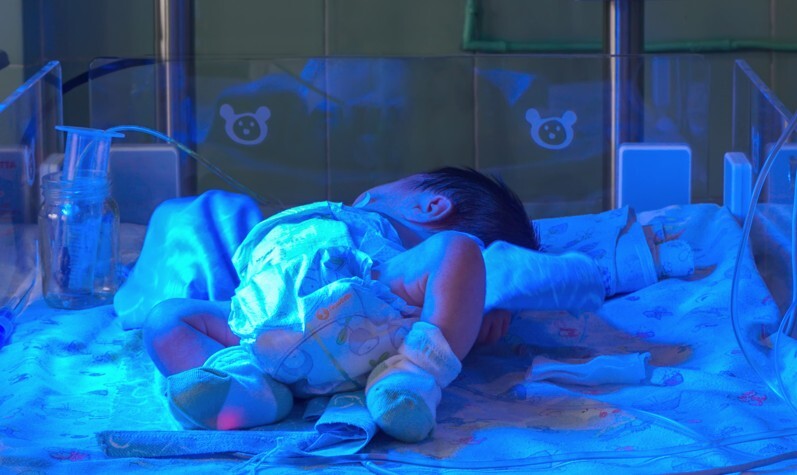Shining a Light on Neonatal Care: How NIR Technology is Changing the Game
In neonatal care, every second counts and every tool matters. Tiny patients, delicate bodies, and high-stakes situations demand devices that are precise, reliable, and gentle. Enter Near-Infrared (NIR) light, the quiet powerhouse of non-invasive diagnostics. With its ability to see inside the body without poking, prodding, or disrupting fragile physiology, NIR is quietly transforming neonatal medicine.
This article explores how NIR technology is making a tangible difference, from monitoring oxygen levels to providing insights into the brain; all while keeping babies safe and comfortable.
Why NIR Light Works So Well
Near-Infrared light lives in a special part of the spectrum, between 700 and 2500 nanometers [1]. Its superpower? It can pass through tissues, giving clinicians a window into the body without invasive procedures. NIR interacts with oxygen, water, and hemoglobin, revealing vital physiological information that’s essential in neonates, where every detail matters [1].
Why Neonatal Care Loves NIR
Neonates are tiny, complex, and incredibly sensitive. Traditional diagnostics can feel like using a sledgehammer to crack a walnut. NIR offers a softer, smarter alternative:
- Non-Invasive & Gentle: No needles, no probes.
- Real-Time Insights: Immediate feedback keeps up with rapidly changing conditions.
- Compact & Convenient: Many devices are portable, making bedside monitoring easy.
NIR in Action
- Monitoring Oxygen and Blood Flow
Oxygen is life’s currency for newborns. NIR spectroscopy (NIRS) tracks how oxygenated and deoxygenated hemoglobin absorb light, giving clinicians continuous, real-time data.
- Clinical Spotlight: NIRS is critical for monitoring cerebral oxygenation, detecting hypoxia before it becomes dangerous.
- Why It Works: Continuous, non-invasive monitoring means faster intervention and better outcomes.
- Fighting Jaundice Without Needles
Jaundice affects many newborns, and traditional blood tests can be stressful for everyone. NIR devices like transcutaneous bilirubinometers measure bilirubin through the skin.
- Clinical Spotlight: Tools like BiliCare provide instant readings with no needles required.
- Why It Works: Faster results, less stress, and happier babies and parents.
- Peeking Inside the Brain
Functional NIRS (fNIRS) maps brain activity by monitoring oxygenation changes in response to neuronal activity.
- Clinical Spotlight: Researchers are studying hypoxic-ischemic encephalopathy and tracking therapeutic responses.
- Why It Works: A real-time window into brain activity; all non-invasive.
- Detecting Infections Early
Infections in neonates can escalate rapidly. NIR spectroscopy is being explored to detect tissue changes or biomarkers associated with sepsis.
- Emerging Tech: Potential to cut diagnostic times dramatically, leading to faster interventions.
- Why It Works: Early detection saves lives.
- Therapeutic Applications
NIR isn’t just for diagnostics. It’s also showing promise in therapies like promoting wound healing and reducing inflammation, making it a versatile tool in NICUs.
Challenges on the Horizon
Of course, no technology is perfect:
- Tiny Targets: Devices must be ultra-precise to work on small neonates.
- Consistency Matters: Standardized protocols are key for reliable results.
- Cost Considerations: Advanced NIR devices can be expensive, limiting access in some hospitals.
But innovation and collaboration continue to push these barriers aside, proving that the toughest challenges often produce the brightest ideas.
The Future is NIR-Powered
Looking ahead, imagine wearable NIR devices providing continuous monitoring, AI analyzing data instantly, and applications extending beyond neonates into broader pediatric care. Picture a NICU where real-time insights guide every intervention like a well-orchestrated symphony.
This isn’t sci-fi, it’s where neonatal care is heading. With NIR light, we’re giving our tiniest fighters a brighter start and more precise care, one gentle beam at a time. Because in neonatal medicine, brilliance isn’t optional, it’s essential.
References:
[1] “What Is Near-Infrared Light and Its Applications?” Biology Insights, 25 July 2025, biologyinsights.com/what-is-near-infrared-light-and-its-applications/.
If you have questions about the development process, feel free to reach out for help. We do hundreds of free consults every year to help guide innovators along their path of device development.

